
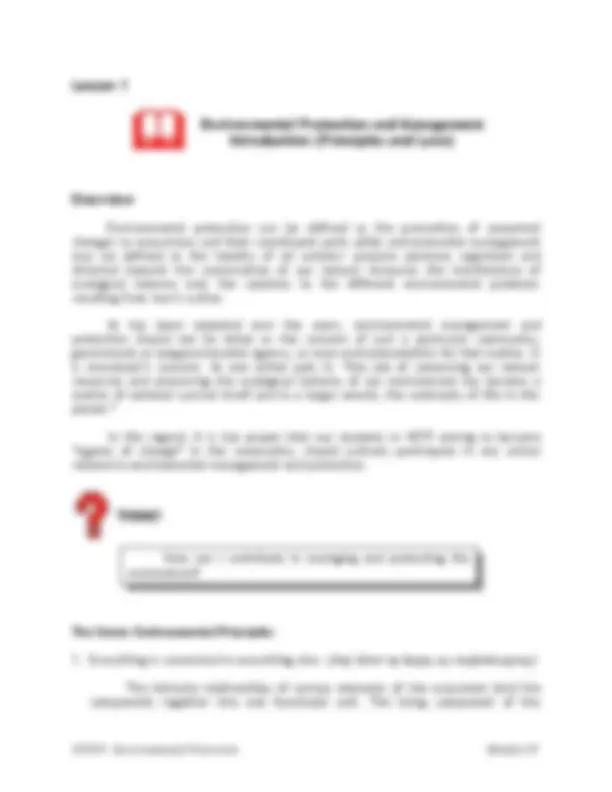
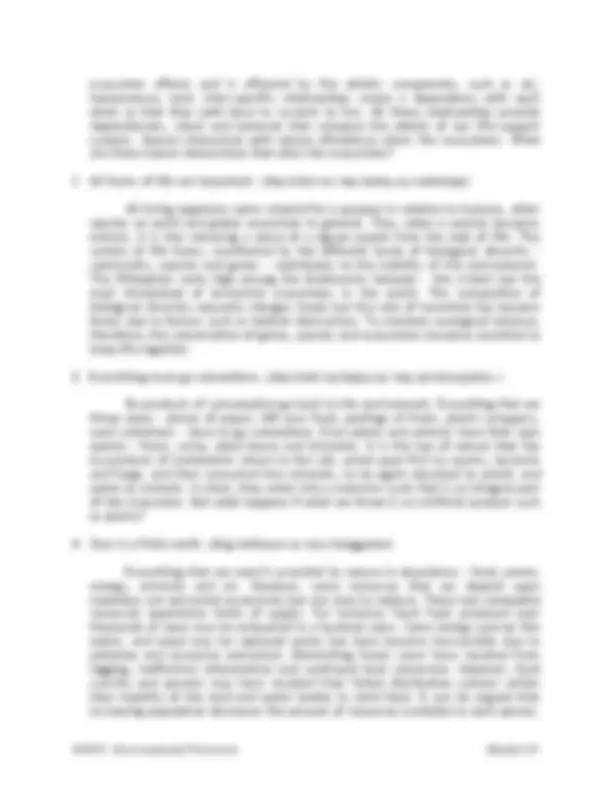
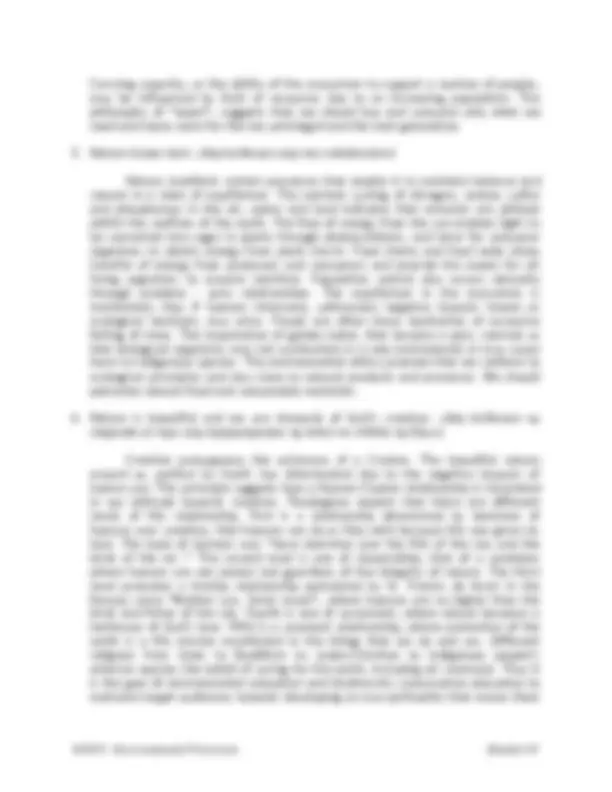


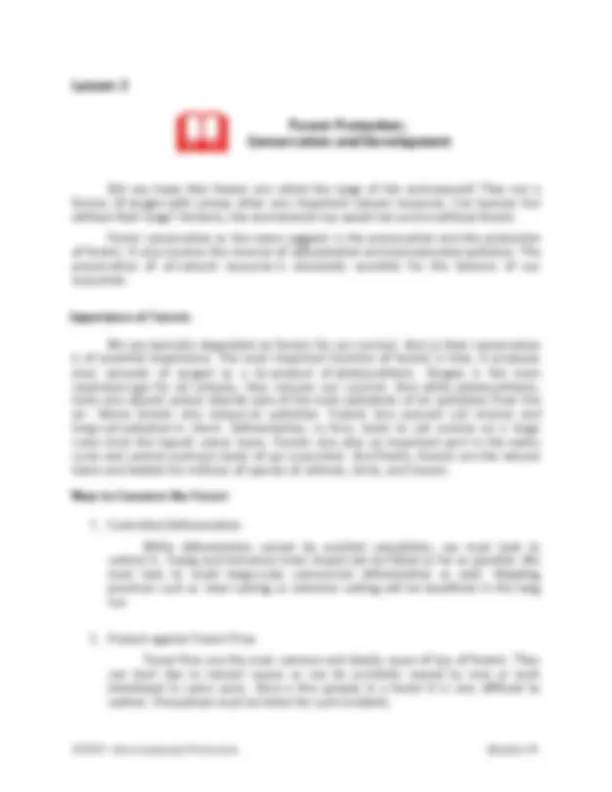
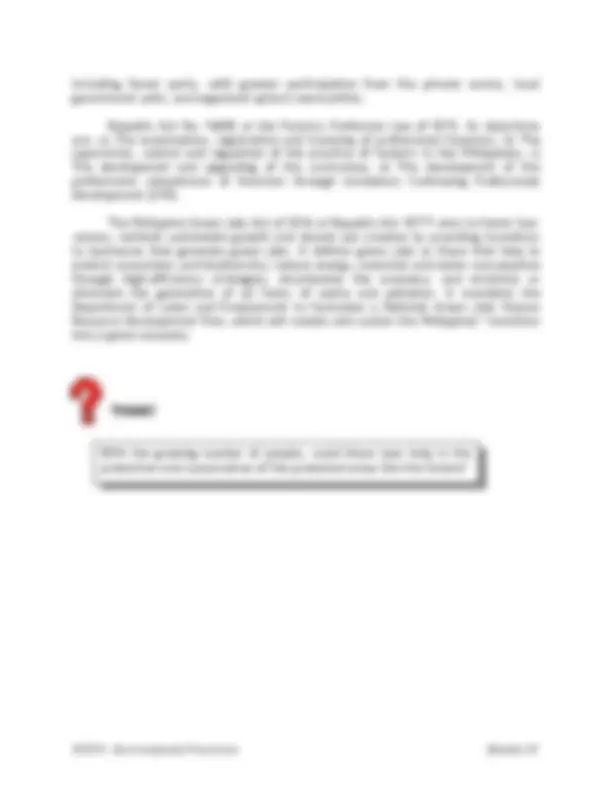

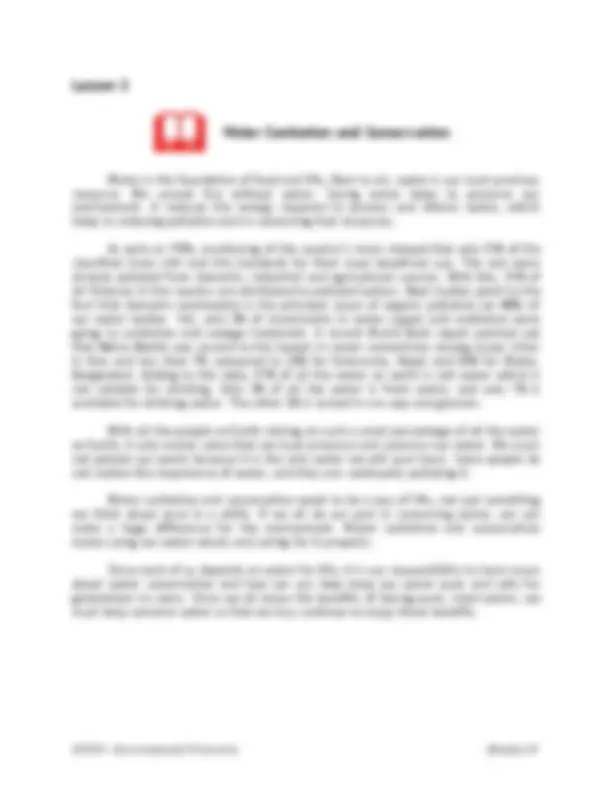
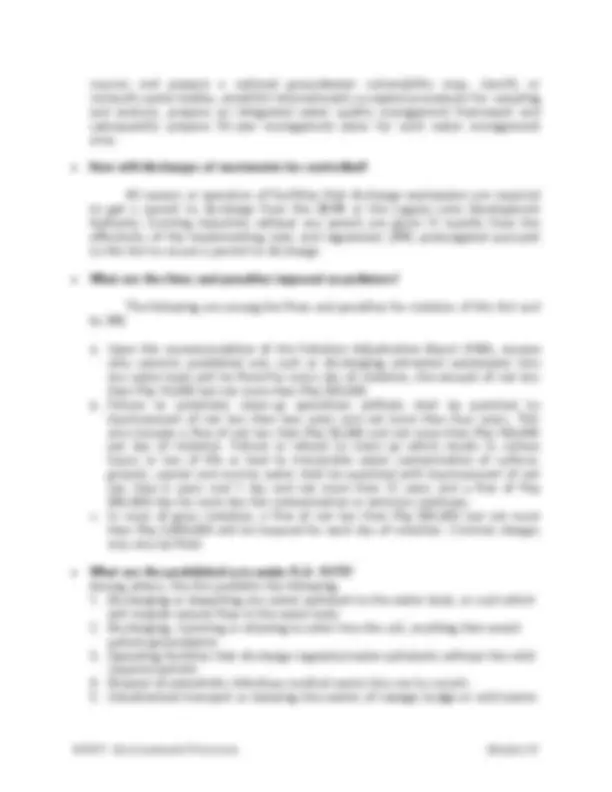

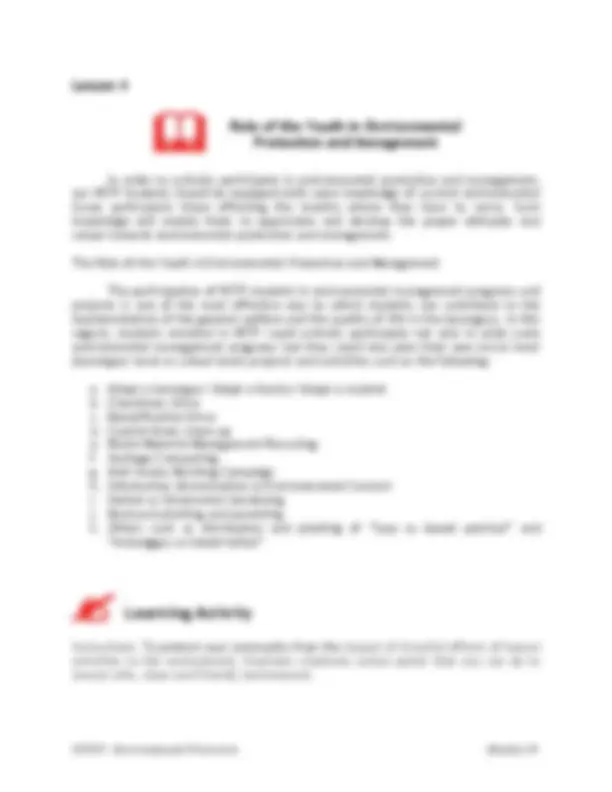

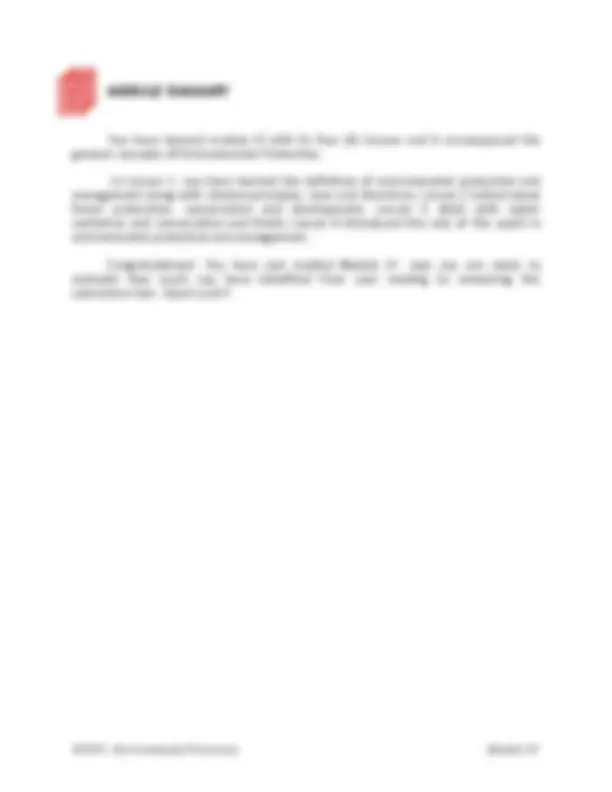
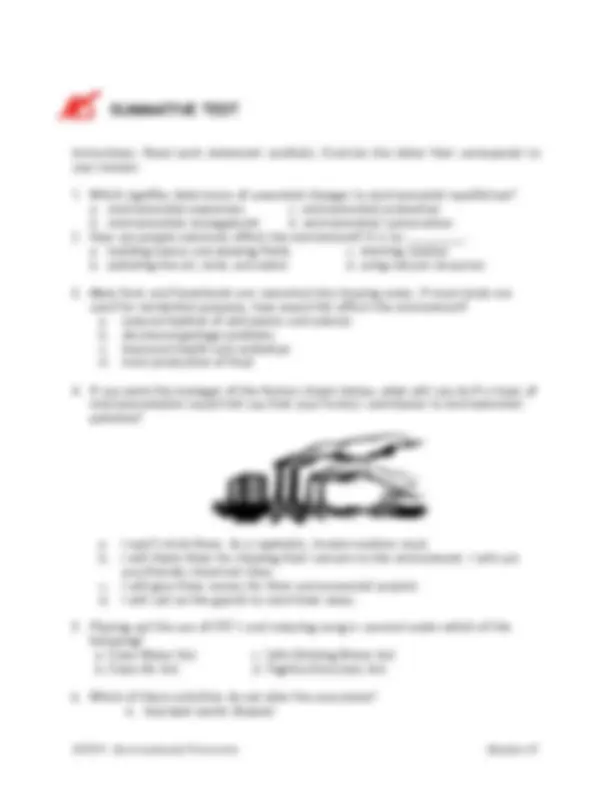
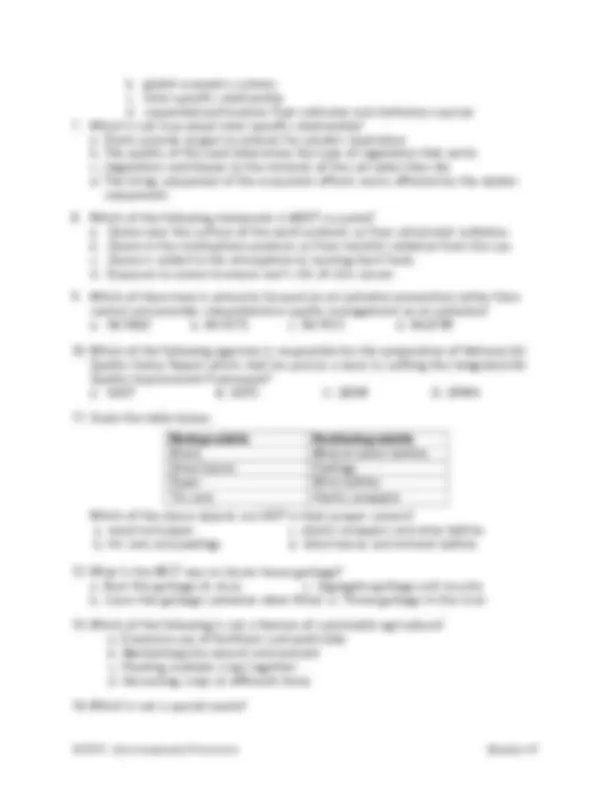

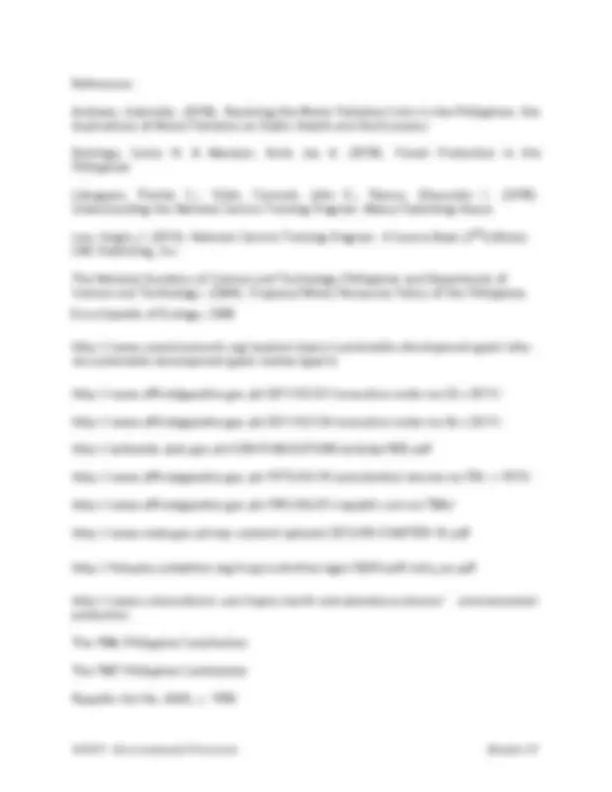



Study with the several resources on Docsity

Earn points by helping other students or get them with a premium plan


Prepare for your exams
Study with the several resources on Docsity

Earn points to download
Earn points by helping other students or get them with a premium plan
Community
Ask the community for help and clear up your study doubts
Discover the best universities in your country according to Docsity users
Free resources
Download our free guides on studying techniques, anxiety management strategies, and thesis advice from Docsity tutors
jglkvtshgilvu khb7d bv o75 oy7gj,y
Typology: Lecture notes
1 / 27

This page cannot be seen from the preview
Don't miss anything!




















This module discusses concepts on environmental management and protection. Current Philippine environmental situation along with principles and laws will also be presented. It is hoped that you will realize the impact of stressful effects of human activities to the environment. Furthermore, we hoped that you will be sensitive in dealing with these actions and be more responsible in protecting and enhancing the environment.
After studying the module, you should be able to:
There are four lessons in the module. Read each lesson carefully then answer the exercises/activities to find out how much you have benefited from it. Work on these exercises carefully and submit your output to your trainer or to the NSTP office.
In case you encounter difficulty, discuss this with your trainer during the face- to-face meeting. If not contact your trainer through SMS or other mode of communication.
Good luck and happy reading!!!
ecosystem affects and is affected by the abiotic components, such as air, temperature, land. Inter-specific relationships create a dependency with each other so that they both have to co-exist to live. All these relationships provide dependencies, check and balances that compose the details of our life-support systems. Human interaction with nature oftentimes alters the ecosystems. What are these human interactions that alter the ecosystems?
All living organisms were created for a purpose in relation to humans, other species on earth and global ecosystem in general. Thus, when a species becomes extinct, it is like removing a piece of a jigsaw puzzle from the web of life. The variety of life forms, manifested by the different levels of biological diversity – community, species and genes – contributes to the stability of the environment. The Philippines ranks high among the biodiversity hotspots – the richest but the most threatened of terrestrial ecosystems in the world. The composition of biological diversity naturally changes slowly but the rate of transition has become faster due to factors such as habitat destruction. To maintain ecological balance, therefore, the conservation of genes, species and ecosystems becomes essential to keep life together.
By-products of consumption go back to the environment. Everything that we throw away – pieces of paper, left-over food, peelings of fruits, plastic wrappers, used containers – have to go somewhere. Even plants and animals have their own wastes – feces, urine, dead leaves and branches. It is the law of nature that the by-products of metabolism return to the soil, acted upon first by worms, bacteria and fungi, and then converted into minerals, to be again absorbed by plants and eaten by animals. In short, they enter into a material cycle that is an integral part of the ecosystem. But what happens if what we throw is an artificial product such as plastic?
Everything that we need is provided by nature in abundance – food, water, energy, minerals and air. However, some resources that we depend upon nowadays are extracted excessively but are slow to replace. These non-renewable resources experience limits of supply. For instance, fossil fuels produced over thousands of years may be exhausted in a hundred years. Some energy sources like water, and wood may be replaced easier but have become inaccessible due to pollution and excessive extraction. Diminishing forest cover have resulted from logging, ineffective reforestation and continued land conversion. However, food scarcity and poverty may have resulted from failed distribution systems rather than inability of the land and water bodies to yield food. It can be argued that increasing population decreases the amount of resources available to each person.
Carrying capacity, or the ability of the ecosystem to support a number of people, may be influenced by limit of resources due to an increasing population. The philosophy of “sapat ”, suggests that we should buy and consume only what we need and leave some for the less privileged and the next generation.
Nature manifests certain processes that enable it to maintain balance and remain in a state of equilibrium. The nutrient cycling of nitrogen, carbon, sulfur and phosphorous in the air, water and land indicates that minerals are utilized within the confines of the earth. The flow of energy from the sun enables light to be converted into sugar in plants through photosynthesis, and later for consumer organisms to obtain energy from plant starch. Food chains and food webs allow transfer of energy from producers and consumers and provide the means for all living organisms to acquire nutrition. Population control also occurs naturally through predator – prey relationships. The equilibrium in the ecosystem is maintained, thus if humans intervene, unforeseen negative impacts known as ecological backlash, may arise. Floods are often times backlashes of excessive felling of trees. The importation of golden kuhol, that became a pest, reminds us that biological organisms may not acclimatize in a new environment or may cause harm to indigenous species. The environmental ethics promote that we conform to ecological principles and stay close to natural products and processes. We should patronize natural food and consumable materials.
Creation presupposes the existence of a Creator. The beautiful nature around us, perfect by itself, has deteriorated due to the negative impacts of human use. This principle suggests how a Human-Creator relationship is translated in our attitude towards creation. Theologians explain that there are different levels of this relationship. First is a relationship determined by dominion of humans over creation, that humans can do as they wish because this was given by God. The book of Genesis says “have dominion over the fish of the sea and the birds of the air…” The second level is one of stewardship, that of a caretaker where humans are not owners but guardians of the integrity of nature. The third level promotes a kinship relationship postulated by St. Francis de Assisi in the famous verse “Brother sun, Sister moon”, where humans are no higher than the birds and fishes of the sea. Fourth is one of sacrament, where nature becomes a testimony of God’s love. Fifth is a covenant relationship, where protection of the earth is a life mission manifested in the things that we do and say. Different religions from Islam to Buddhism to Judeo-Christian to indigenous people’s animism express the belief of caring for the earth, including all creatures. Thus it is the goal of environmental education and biodiversity conservation education to motivate target audiences towards developing an eco-spirituality that moves them
Republic Act No. 9003 or the Ecological Solid Waste Management Act of 2000 was approved giving strong emphasis on the role of municipal and local government units in Solid Waste Management. Solid Waste in this case includes all discarded, households, commercial, industrial, institutional and agricultural debris or wastes which may be non-hazardous or hazardous. This act considers non-hazardous solid waste as resource that can be recovered through recycling, re-use, recovery and composting thus eventually minimizing the bulks of waste that has to be collected and treated or incinerated.
Republic Act No. 9512 or the National Environmental Awareness and Education Act of 2008. An act to promote environmental awareness through environmental education and for other purposes. This is giving institutional agencies to integrate environmental education in its school curricula at all levels, whether public or private, including in barangay daycare, preschool, non-formal, technical vocational, professional level, indigenous learning and out-of-school youth courses or programs. Environmental education shall encompass environmental concepts and principles, environmental laws, the state of international and local environment, local environmental best practices, the threats of environmental degradation and its impact on human well-being, the responsibility of the citizenry to the environment and the value of conservation, protection and rehabilitation of natural resources and the environment in the context of sustainable development.
Climate Management or RA 9729, s.2009, or the Climate Change Act, is based on declared policy of the State to systematically integrate the concept of climate change in various phases of policy formulation, development plans, poverty reduction strategies and other development tools and techniques by all agencies and instrumentalities of the government. We must remember that Segregated Waste = Resources and Mixed Waste = Garbage. In order to reduce waste, we have to segregate the biodegradable (compostable) from non- biodegradable (recyclable) waste. In the disposal of waste, observance to the prevailing laws, rules and regulations is crucial. These can be contained in the Waste Management System or Manual of the organization.
CHED Memorandum Order No. 33, series of 2009. Integration of Environmental Education in the tertiary education curriculum particularly the Civic Welfare Training Service (CWTS) component of the National Service Training Program.
Philippine Development Plan 2017-2022. In October 2016, President Rodrigo Duterte signed off on AmBisyon Natin 2040, a long-term vision that articulates the Filipinos’ aspirations 99 for a strongly-rooted, comfortable and secure life. Anchored on this vision, the Philippine Development Plan (PDP) 2017- 2022 details the country’s development strategies to achieve inclusive growth, a high-trust and resilient society, and a globally competitive knowledge economy. Supporting the goal to build resilient communities and reduce poverty, 11 chapters in the PDP 2017-2022 involve climate- related policies and measures. These promote climate-resilient infrastructure, energy
efficient technologies, forest rehabilitation, and improved health services for disaster and climate-related illnesses. Waste Management Improper or mega dosage use of cleaning chemicals, mounting packing materials of delivered equipment/tools and empty or used containers, limited storing, recycling and disposal area of wastes coming from training workshops, i.e. welding stubs, electronic devices, are few of the issues to be dealt with in this topic. Waste management is the collection, transport, processing, recycling or disposal of waste materials, usually ones by human activity, in an effort to reduce their effect on human health or local aesthetics or amenity. A sub focus in recent decades has been to reduce the effect of waste materials on the environment and to recover resources from them.
Instructions: On the space below, paste a magazine or newspaper cutout of any photograph that shows destruction of the environment. Then, answer the questions that follow.
Did you know that forests are called the lungs of the environment? They are a factory of oxygen with various other very important natural resources. Can humans live without their lungs? Similarly, the environment too would not survive without forests. Forest conservation as the name suggests is the preservation and the protection of forests. It also involves the reversal of deforestation and environmental pollution. The preservation of all natural resources is absolutely essential for the balance of our ecosystem.
Importance of Forests
We are basically dependent on forests for our survival. And so their conservation is of essential importance. The most important function of forests is that, it produces mass amounts of oxygen as a by-product of photosynthesis. Oxygen is the main respiratory gas for all animals, thus ensures our survival. And while photosynthesis, trees also absorb carbon dioxide (one of the main pollutants of air pollution) from the air. Hence forests also reduce air pollution. Forests also prevent soil erosion and keep soil pollution in check. Deforestation, in fact, leads to soil erosion on a large scale since the topsoil comes loose. Forests also play an important part in the water cycle and control moisture levels of our ecosystem. And finally, forests are the natural home and habitat for millions of species of animals, birds, and insects.
Ways to Conserve the Forest
While deforestation cannot be avoided completely, we must look to control it. Young and immature trees should not be felled as far as possible. We must look to avoid large-scale commercial deforestation as well. Adapting practices such as clear-cutting or selective cutting will be beneficial in the long run.
Slash and burn farming, overgrazing by cattle, shifting agriculture pattern are all farming practices that are harmful to the environment and particularly to forests. We must keep all these practices under control.
Related Laws and Directives governing Forest Protection, Conservation and Development
Presidential Decree No. 705, series of 1975. Revising Presidential Decree No. 389, otherwise known as the Forestry Reform Code of the Philippines. This Act lays down the basic principles of forest management and conservation, makes provision for the administration of forestry (Chap. I), the survey and classification of lands for purposes of forestry (Chap. II), and the use of forest resources (Chap. III). And, places emphasis not only on the utilization of forest resources but more so on the protection, rehabilitation and development of forest lands, in order to ensure the continuity of their productive condition
Executive Order No. 277 amending section 68 of Presidential Decree No. 705 otherwise known as the "Revised Forestry Code of the Philippines". Section 68 of Presidential Decree No. 705 has been amended for the purpose of penalizing possession of timber or other forest products without a license required by existing forest laws, authorizing the confiscation of illegally cut, gathered, removed and possessed forest products, and granting rewards to informers of violations of forestry laws, rules and regulations.
Executive Order No. 192 of 1987, which called for the reorganization of Department of Environment, Energy and Natural Resources, renaming it as the Department of Environment and Natural Resources and for other purposes. It also created the Forest Management Bureau with the mandate of providing technical assistance not only to the central office but also to the field offices for the effective protection, development, and conservation of forestlands and watersheds. The bureau also has the power to recommend interventions in meeting the goals of sustainable forests with good governance (FMB 2016).
Republic Act No. 7586, series of 1992. An act providing for the establishment and management of National Integrated Protected Areas System (NIPAS), defining its scope and coverage, and for other purposes. It shall encompass "outstandingly remarkable areas and biologically important public lands that are habitats of rare and
including forest parks, with greater participation from the private sector, local government units, and organized upland communities.
Republic Act No. 10690 or the Forestry Profession Law of 2015. Its objectives are: a) The examination, registration and licensing of professional foresters; b) The supervision, control and regulation of the practice of forestry in the Philippines; c) The development and upgrading of the curriculum; d) The development of the professional competence of foresters through mandatory Continuing Professional Development (CPD).
The Philippine Green Jobs Act of 2016 or Republic Act 10771 aims to foster low- carbon, resilient sustainable growth and decent job creation by providing incentives to businesses that generate green jobs. It defines green jobs as those that help to protect ecosystems and biodiversity; reduce energy, materials and water consumption through high-efficiency strategies; decarbonize the economy; and minimize or eliminate the generation of all forms of waste and pollution. It mandates the Department of Labor and Employment to formulate a National Green Jobs Human Resource Development Plan, which will enable and sustain the Philippines’ transition into a green economy.
With the growing number of people, could these laws help in the protection and conservation of the protected areas like the forests?
Instructions: If given a chance to be the overall in-charge of the protected areas of the country, what will be your three (3) priority programs for the forest protection, conservation and development? Explain
Related Laws and Directives governing Water Sanitation and Conservation
The Water Resources Policy
This is embodied in Resolution No. 20 Series 1975 of the National Economic Development Authority (NEDA) Board entitled Establishing Basic Policies Regarding the Control, Conservation, Development and Utilization of the Water Resources of the Country unanimously adopted on January 20, 1975_._ Although some specific policies have been adopted from time to time, such as: the Water Crisis Act of 1995, NEDA Board Resolutions, NWRB Board Resolutions, Executive Orders, and Medium Term Development Plans.
While the ways of using water may change with time, there are some basic principles in water management that are relatively permanent as some have been decreed and others have been universally accepted. Among these are:
a. Ownership of Water. The 1986 Constitution provides in Article XII, Section 2 that "All ... waters ... and other natural resources are owned by the State ... and shall not be alienated. The exploration, development, and utilization of natural resources shall be under the full control and supervision of the State ... In cases of water rights for irrigation, water supply, fisheries or industrial uses other than the development of water power, beneficial use may be the measure and limit of the grant ... " Similar provisions were also provided in the 1974 and 1935 Constitutions. Such water policy is also provided in Chapter I and II of the 1976 Philippine Water Code (PD 1067)
b. Water Cycle. The hydrologic cycle illustrates how surface water, groundwater and water in the atmosphere are interrelated. As long as the sun shines and provides the needed energy, the hydrologic cycle continues as it is closely linked with the land surface, vegetation, soil, underlying rocks, water bodies and the atmosphere.
c. Integrated Water Resources Management (IWRM). IWRM is the globally recognized process that will ensure the sustainable development and management of a country's water resources. As defined by the Global Water Partnership, which this study has arbitrarily adopted, "IWRM is a process which aims to ensure the coordinated development and management of water, land and related resources
What can I contribute to preserve and conserve the quality of water for future generations?
to optimize economic and social welfare without compromising the sustainability of vital environmental systems."
d. Water as a Finite and Vulnerable Resource. "Fresh water is a finite and vulnerable resource essential to sustain life, development and the environment. Since water sustains life, effective development and management of water resources demands a holistic approach, linking social and economic development with protection of natural ecosystems.
e. Participatory Approach. "Water development and management should be based on a participatory approach. Involving users, planners and policy-makers at all levels. The participatory approach involves raising awareness of the importance of water among policy-makers and the general public. It means that decisions are taken at the lowest appropriate level, with full public consultation and involvement of users in the planning and implementation of water projects.
f. Water as an Economic Good. "Water has an economic value in all its competing uses and should be recognized as an economic good. Within this principle, it is vital to recognize first the basic right of all human beings to have access to clean water and sanitation at an affordable price. Past failure to recognize the economic value of water has led to wasteful and environmentally damaging uses of the resource. Managing water as an economic good is an important way of achieving efficient and equitable use, and of encouraging conservation and protection of water resources.''
The Clean Water Act
The Philippine Clean Water Act of 2004 (Republic Act No. 9275) aims to protect the country’s water bodies from pollution from land-based sources (industries and commercial establishments, agriculture and community/household activities). It provides for a comprehensive and integrated strategy to prevent and minimize pollution through a multi-sectoral and participatory approach involving all the stakeholders. Specifically, this legislative intends to apply water quality management in all water bodies in order to implement abatement and control of pollution from land-based sources.
Highlights of the Clean Water Act
Who should implement the Clean Water Act?
The DENR is the primary government agency responsible for the implementation and enforcement of this Act, with the support of other government organizations, local government units, non - government organizations and the private sector. Towards this end, the DENR will review and set affluent standards, review and enforce water quality guidelines, classify groundwater
Instruction: Prepare two slogans about the clean water act campaign of the government.
In order to actively participate in environmental protection and management, our NSTP students should be equipped with some knowledge of current environmental issues particularly those affecting the locality where they have to serve. Such knowledge will enable them to appreciate and develop the proper attitudes and values towards environmental protection and management.
The Role of the Youth in Environmental Protection and Management
The participation of NSTP students in environmental management programs and projects is one of the most effective way by which students can contribute to the implementation of the general welfare and the quality of life in the barangays. In this regard, students enrolled in NSTP could actively participate not only in wide scale environmental management programs but they could also plan their own micro level (barangays level or school level) projects and activities such as the following:
a. Adopt a barangay/ Adopt a family/ Adopt a student b. Cleanliness Drive c. Beautification Drive d. Coastal Areas clean-up e. Waste Material Management/Recycling f. Garbage Composting g. Anti-Smoke Belching Campaign h. Information dissemination or Environmental Concern i. Herbal or Ornamental Gardening j. Backyard planting and parenting k. Others such as distribution and planting of “luya sa bawat pamilya” and “malunggay sa bawat bahay”
Instructions: To protect your community from the impact of stressful effects of human activities to the environment, illustrate creatively action points that you can do to ensure safe, clean and friendly environment.